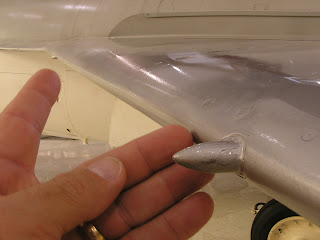There was concern that the vertical straps would slip along the leading edge of the left and right wings differently before snagging, which would result in the airplane being yanked to one side or the other (into the island or off the deck). As a result, small fences (or protruding pins in the case of the F11F Tiger) were added along the wing's leading edge.
The F4D Skyray provides an early example. There were three fences along the wing leading edge as shown in these Bill Spidel photos.:
(Note that the leading edge slats would normally be extended.)
These small fences were also present on the A4D Skyhawk, F3H Demon, and the FJ-2/3/4 Fury (the FJ-2 was introduced about the same time as the barricade and did not initially have them; neither did the early FJ-3s. However, at least some (probably all) FJ-2s were retrofitted with them, as were all FJ-3s not originally delivered with them).
As previously mentioned, the Grumman F11F Tiger used pins instead of fences as shown in this Don Hinton photo:
The F7U Cutlass didn't have these fences, probably because the leading-edge slats were extended mechanically rather that aerodynamically, providing a snag point on each wing along with the gap between the fuselage and the engine inlet.
The Grumman Cougars did not have the small scabbed-on fences either, probably because there was a large aerodynamic fence on the inboard section of the wing and a protrusion at the wing tip that provided snag points.
This December 1953 F9F-6 Cougar encounter with the early barricade appears to have been somewhat compromised by the fact that the Davis barrier only engaged the right main landing gear, causing the airplane to begin to slew around to the right before it got to the barricade.
Note the location of the upper suspension strap of the barricade, fortunately behind the canopy and not in the cockpit; the prospect of eating the suspension strap in a barricade encounter resulted in many pilots opting to land with the canopy closed.









No comments:
Post a Comment